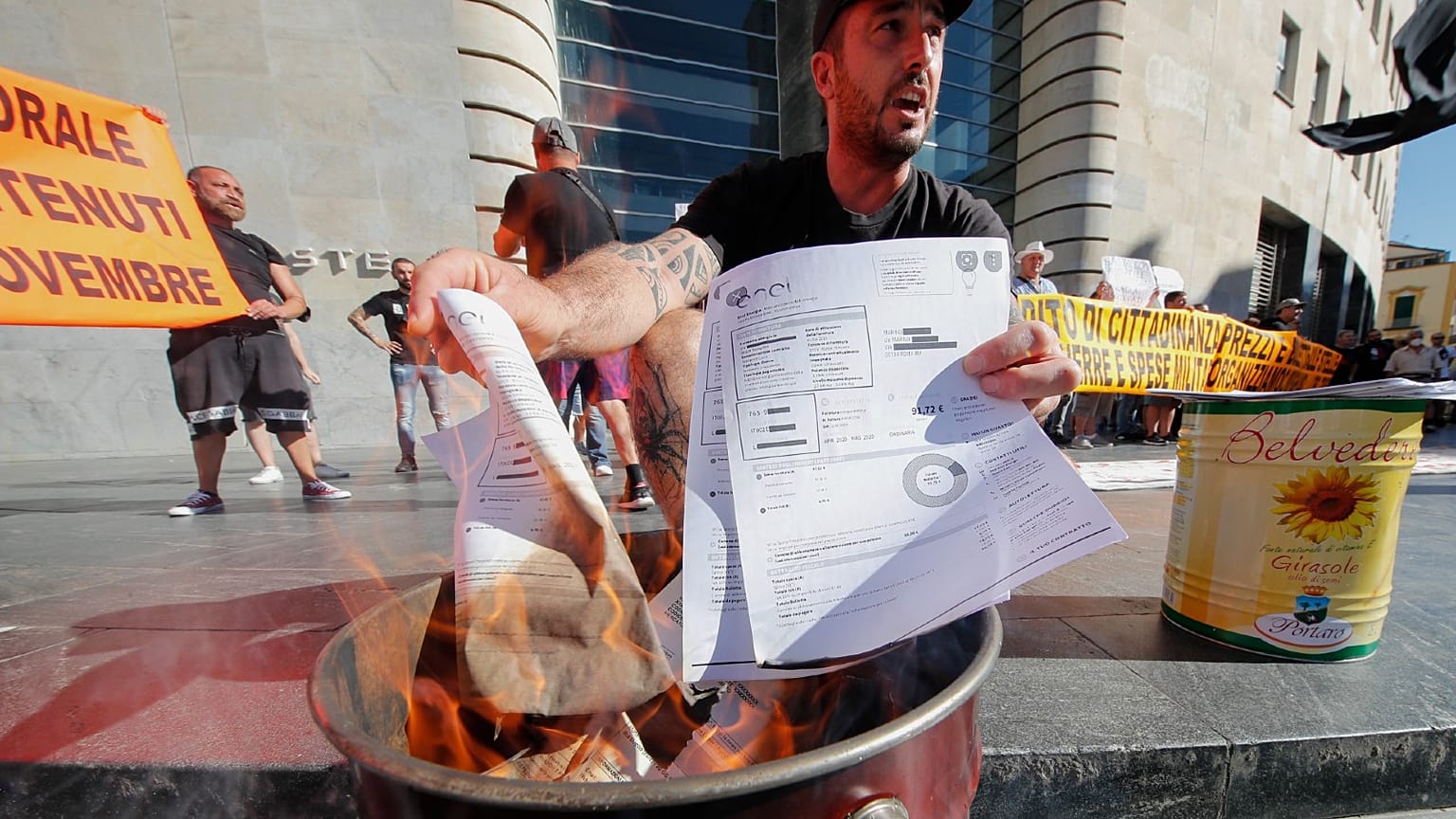The UK's energy bills will jump by 80% a year from October. But how do Britain's prices compare with the rest of Europe? Who in Europe is paying the most? Who is paying the least?
Energy bills in the UK will leap by 80% this winter, the country's energy regulator Ofgem announced on Friday, as the Ukraine war continues to drive up prices.
The hike means the average household will pay €4,182 (£3,549) each year to heat and power their homes, leading NGOs to warn that millions will be plunged into poverty -- unless the government steps in.
But how do UK energy prices compare to those across Europe?
These infographics show which European households are forking out the most for their gas and electricity bills and those paying the least.
Electricity prices
The above chart shows how much those living in Europe are paying on average for their electricity.
Even before today's hike was announced, UK households faced some of the highest prices in Europe -- nearly double France. Only the Czech Republic was higher than the UK, which was followed by Italy and Estonia.
Norway, which has large reserves of oil and gas, has the cheapest electricity bills, ahead of Switzerland and Malta in second and third, respectively.
Having recently struck new energy deals with Russia, households in Hungary are also paying some of the lowest rates for their electricity in Europe.
The chart is based on data for July and compares prices for households in European capitals.
To standardise the data -- and so make a comparison possible -- the prices are adjusted to purchasing power standards (PPS), which eliminates the price level differences between countries by using an artificial common currency.
Gas prices
Using the same methodology as the previous infographic, this chart compares gas prices in Europe.
While there are some similarities to electricity prices -- with both Hungary and Serbia paying the least for their gas -- most countries fare differently.
Bulgaria, the Netherlands and Greece are at the unfortunate top spot, with households grappling with energy prices way above the European average.
The UK, which does not import a single whiff of gas from Russia, lies in the middle of the chart, although the recent price hike is set to push the country towards the upper end of the pile.
What has been the long-term trend for household electricity prices?
But are the UK's higher household electricity bills a temporary blip?
Let's take a look at how prices have changed over time in both the UK and EU.
UK prices have been higher than the EU average for at least five years, with the gap widening in the aftermath of the COVID lockdown and the war in Ukraine.
Coinciding with Russia's invasion in February, prices in the UK have risen much more steeply than in the EU, reaching almost double the European average in July.
But, with bills soaring long before even whispers of the conflict in Ukraine, it appears deeper, more structural problems are at play in the UK.
Issues with how the UK energy market is designed and regulated have been cited by experts as making the country more vulnerable to price spikes.
Some critics say the country's fully privatised energy market — which can be traced back to Margaret Thatcher’s liberalisation drive in the 1980s — is partly to blame.
What has been the long-term trend for household gas prices?
Up until late 2021, the UK enjoyed cheaper gas than the EU average.
However, since then, Britons have paid substantially more than those in Europe. The last time in recent history they paid more than Europeans was in 2009.
One reason why prices are rising faster in the UK is that, while the country only imports a small percentage of its gas from Russia, it relies more heavily on gas than its European neighbours because it has less nuclear and renewable energy.
The UK also does not have as much capacity to store gas, forcing it to buy on short-term markets where there is greater volatility in prices.
While gas prices take off when Russia invaded Ukraine, it is notable that they had already begun to accelerate much more in the UK than in Europe long before the conflict broke out.
COVID, Brexit and a lack of effective energy policies and planning by the UK government have also impacted bills significantly.
So what are European countries doing about it?
Energy prices are growing in every European country, though the fallout for people is not the same.
This is largely due to governments stepping in to try and shield households from the seemingly never-ending surge in gas and electricity prices.
The UK -- waiting to know who its next prime minister will be -- has been criticised for not doing enough to help people cope with the price increases.
In spring the government announced all households will get a £400 rebate on energy bills, meaning £60 will be knocked off energy bills every month for six months.
However, energy prices have skyrocketed since the measures were revealed, and from October a typical household will see monthly energy bills of around £300 a month.
But the situation is not the same in other major European countries.
France
France is also offering a one-off payment to its citizens to help them face hard times, though at just €100 this is considerably lower than in the UK and Italy.
But France has stepped up its game at the source, forcing the country's state-owned energy provider EDF to limit electricity wholesale price rises to 4% a year.
This price cap, set to last until 31 December, is one of the reasons why the French have some of the lowest gas and electricity prices in Europe, as outlined in the above charts.
However, the country's largest source of energy is nuclear, meaning it is less affected by spikes in gas and oil prices.
The government's intervention is expected to cost France €8.4 billion.
France's Minister of Economy, Bruno Le Maire, said in August that access to a €3 billion euro fund for businesses unable to meet their energy bills would be made easier.
Germany
Germany, which is heavily reliant on Russian energy, has pledged to reduce taxation on natural gas from 19% to 7%, on top of measures aimed at cutting energy consumption.
The German government also approved two relief packages totalling €30 billion to help its citizens with rising energy prices this year.
Meanwhile, heavily subsidised public transport tickets -- at €9-a-month -- have been offered to Germans in a bid to alleviate the cost of living crisis and improve the country's green credentials.
German households will still pay almost €500 more a year for their gas due to a new levy -- to be imposed from October -- helping utility companies cover the cost of replacing Russian supplies.
Italy
In August, Italy approved a new aid package worth around €17 billion to help protect people and businesses from surging energy costs.
This came on top of an extra €35 billion set aside since January to fight the cost of living crisis.
Italy has also announced its intention to tax companies profiting from higher energy prices, while promoting a price cap at a European level to help contain price spikes.
Hungary
Hungary's government has declared a state of emergency over energy, tightening rules around price caps.
In what marked a remarkable U-turn on a key policy, Hungarian Prime Minister Viktor Orban scraped energy price limits for high-usage households, though controls remain in place for those using less than the average.
Energy prices have been frozen in Hungary for almost a decade, with households having some of the lowest gas and electricity bills in Europe since 2013.
The average Hungarian's monthly electricity bill comes in at around €19, which would be about five times more if the cap was not in place.
Vowing that Hungary will have enough, Orban has signed new gas deals with Russia, provoking the ire of European leaders.
Spain
Like Italy, Spain has taxed energy companies raking in huge profits from the recent energy price increases and pledged to use the money to help its citizens pay their bills.
Madrid has slashed value-added tax (VAT) on natural gas from 21% to 5%, while also cutting an existing tax on electricity from 7% down to 5%.
The tax reduction will begin in October and last until the end of the year, Spain announced in September.
In recent months, Madrid has increased the number of aid plans to try and compensate for the effects of the rising cost of living for households and businesses, with year-on-year inflation topping 10% for the first time since the 1980s.
Spain currently enforces a one-year cap on gas prices, agreed by the European Commission, which ensures they remain lower than an average of €50 per megawatt-hour.















